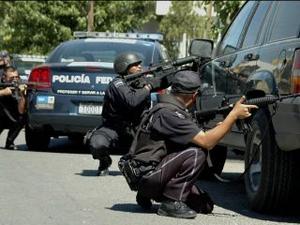MexicoMexico now dominated by two powerful cartels
Five years and more than 35,000 deaths into Mexico’s bloody drug war, two cartels have emerged as the dominant force in narcotics and the two are poised to slug it out in a dangerous battle for control; the Mexican governmen’s crackdown on the drug cartels has left many gangs splintered and operationally less effective without their leaders; in the ensuing power vacuum, the Zetas and Joaquin “El Chapo” Guzman’s Sinaloa cartel have stepped up as the two leading gangs

Government pressure has left only two cartels standing // Source: anomacayou.com
Five years and more than 35,000 deaths into Mexico’s bloody drug war, two cartels have emerged as the dominant force in narcotics and the two are poised to slug it out in a dangerous battle for control.
The Mexican government’s crackdown on the drug cartels has left many gangs splintered and operationally less effective without their leaders. In the ensuing power vacuum, the Zetas and Joaquin “El Chapo” Guzman’s Sinaloa cartel have stepped up as the two leading gangs.
“They are the two most successful cartels, or at least they have been able to expand in recent years,” said Jorge Chabat, a drug trade and security expert.
According to Chabat, the two cartels survived the government’s attacks because they have proven to be more skilled than their counterparts.
As the two cartels battle it out for control, bloody scenes of mass murders have become increasingly common.
Just two weeks ago, in the Gulf coast seaport of Veracruz, thirty-five bound, tortured bodies were dumped on a major roadway during the height of rush hour. The victims were believed to be linked to the Zetas, while the perpetrators are thought to be aligned with the Sinaloa cartel.
Meanwhile, in May a bloody clash resulted in the deaths of more than two dozen people, mostly Zetas, when they tried to infiltrate Sinaloa’s territory in the Pacific Coast state of Nayarit. These types of attacks are known as “spoilers,” which are designed to make trouble on an enemy’s territory rather than actually trying to take over it.
The cartels have even been known to launch poison attacks against civilians on an enemy’s turf in the hopes that the rival will be blamed.
Both cartels are struggling for control of seaports to ship drugs from South and Central America as well as border towns to smuggle drugs into the United States.
“I see the Sinaloa Federation and the Zetas as being the two polarizing forces in the Mexican criminal system … and between the two, an array of other smaller groups aligned with one or the other,” said Samuel Logan, the director of Southern Pulse, a security consulting firm.
Sinaloa is primarily based in Mexico’s northwest Pacific Coast, but in recent years its reach has extended into the east and as far as south as Central America.
The Zetas on the other hand were once the armed wing of the Gulf cartel, and prior to joining the cartel were once part of an elite army unit. In 2010 the Zetas split off from the Gulf cartel after a falling out and eventually usurped control of the Gulf cartel’s territory, the northern Gulf Coast. Since taking over, the Zetas have grown the most of any cartel pushing deep into central Mexico and as far as Guatemala in the south.
Differences between the two cartels are quite stark. Sinaloa prefers to operate in a more discreet fashion donning black ski-masks and clothing, whereas the Zetas are outfitted in military gear and operate military-style training camps.
In addition the Sinaloa cartel is known for entering into temporary alliances, while the Zetas are thought to avoid them instead opting to take direct control over a territory.
While Sinaloa seems primarily focused on narcotics and are more targeted in their use of violence, the Zetas engage in human trafficking and other illegal operations in addition to the drug trade. The Zetas are also responsible for committing some of the worst massacres of the Mexican drug wars yet. Mexican officials say their violence is so brutal it is “irrational.”
“Sinaloa has done well by flying under the radar. They’re comparatively less violent, though they’re no saints,” said Andrew Selee, director of the Washington-based Mexico Institute. “The Zetas have certainly gotten bigger since they split with the Gulf, but whether that will amount to a long-term ability to control and defend the territories where they have a presence is a little less clear. In reality, they’re much thinner, where Sinaloa is hierarchical and compact.”
According to Chabat, the new cartel power structure with only two major forces may make it easier for the government to wage its drug war as it no longer has to fight half a dozen of them.
“The question is whether the Sinaloa cartel and Zetas are going to break at some point or not,” said Chabat. “Right now they are very strong, but if in two or three years these cartels are pulverized, they may say that (the drug war) was a success.”
